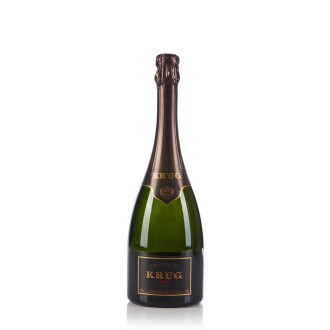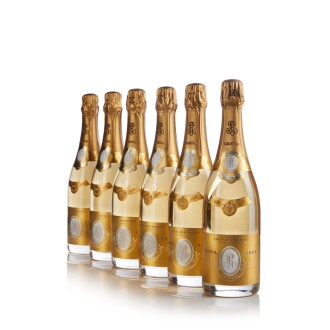C overing an area of 34,000 hectares in northeastern France divided up into 319 villages, Champagne is the world’s best-known and most celebrated sparkling wine. The undisputed quality benchmark against which all other fizz producers measure themselves, Champagne styles run the gamut from fresh and tart to rich and full-bodied. Having once been dismissed as merely a celebratory drink, Champagne is being taken increasingly seriously by collectors and has grown its presence massively on the secondary market in recent years, with prestige cuvées from the top names like Salon and Krug commanding high hammer prices at auction.
The Origins of Champagne, the Wine of Kings

The Champagne region has a rich and illustrious history. Vines were first planted in the area by the Romans in the 5th century AD, who were early to spot its suitability for grape growing. By the 9th century, Champagne's association with the coronation of French Kings in Reims cathedral made the still wine popular across France. It wasn’t until the 17th century, however, that sparkling expressions of Champagne began to emerge and find favour.
While Benedictine monk Dom Pérignon is wrongly credited for inventing sparkling Champagne in 1693, the cellar master at Hautvillers Abbey made his mark on the region, importing stronger glass bottles from England, using corks as stoppers, and reducing yields to improve concentration. Champagne’s oldest house, Ruinart, open its doors in 1729 and the French fizz being enjoyed as a luxury item among the European elite, yet it would take another century before Champagne became globally recognised.
Helping to build Champagne’s global reputation was Barbe-Nicole Ponsardin, better known as “Veuve Clicquot,” who developed the first vintage Champagne, perfected the riddling method, and expanded Champagne’s international presence by pushing exports, turning the sparkling wine into a symbol of luxury and celebration worldwide.

The Terroir of Champagne
Helping the Champagne region to craft sparkling wines of unrivalled excellence are its abundance of limestone-rich chalk soils, which play an important role during the grape growing process, offering superb drainage while retaining moisture during dry periods and reflecting sunlight back onto the vines, helping the grapes to fully ripen.
Champagne’s climate and topography also play their part in creating a distinct terroir that gives the wines their unique characteristics. Champagne has a cool continental climate with oceanic influences, meaning regular rainfall, which can pose problems for winemakers during spring and winter, when frosts and heavy rains can wreak havoc in the vineyards.
The Crus of Champagne
The Champagne region is divided up into 319 villages. Of those, just 42 have been given Premier Cru status, and only 17 have earned ultimate accolade of Grand Cru status. Below are the five main growing regions of Champagne, each known for their distinct qualities.
Montagne de Reims
Located south of Reims between the Marne and Vesle Rivers, Pinot Noir is king here, and is able to achieve optimal ripeness due to the region’s abundance of south-facing vineyards, creating wines of depth and concentration. The area is home to nine of Champagne’s Grand Cru sites, including Ambonnay, Bouzy, Verzy, and Verzenay.
Vallée de la Marne
Running from Tours-sur-Marne and Epernay to the city of Paris along the right bank of the Marne River, this area is home to two Grand Cru sites: Aÿ, located just outside Épernay, and Tours-sur-Marne. Pinot Noir and Meunier are the main focus here, leading to rich and robust styles of Champagne with smoky, earthy flavours.
Côte des Blancs
Located a few kilometers from Epernay, we’re in Chardonnay country here, which accounts for around 95% of production. Facing east and drenched in sunlight, it’s the source of some of the finest blanc de blancs from Champagne and home to six Grand Cru sites: Avize, Chouilly, Cramant, Le Mesnil-sur-Oger, Oger and Oiry.
Côte de Sézanne
South of the Côte des Blancs is the Côte de Sézanne, where the focus is firmly on Chardonnay, which accounts for three quarters of its production, though the grapes grown here are usually used in blends rather than blanc de blancs expressions.
Côte des Bar
Slightly apart from the rest of region, the Côte des Bar lies on the border between Champagne and Burgundy. We’re in Pinot Noir territory here, so the wines made are rich and full-bodied, and often offer exceptional value.

The Principle Grapes of Champagne
While Chardonnay, Pinot Noir and Meunier account for 99% of grape plantings in the region, winemakers are also able to work with four other permitted grapes: Pinot Blanc, Pinot Gris, Petit Meslier and Arbane in their blends.
Each of the three principal grapes brings something to the table within Champagne blends. White grape Chardonnay brings freshness, elegance and finesse to the party. Its high acid is an asset, helping the wines to age gracefully, often for decades, while retaining their vitality.
Black grape Pinot Noir – the most widely planted in Champagne – brings power and complexity to blends, increasing the body, structure and texture of the wines. Its fellow black grape, Meunier, also has an important role to play, imbuing blends with a wonderful softness and fruitiness, and a brightness from its higher acidity levels compared to Pinot.

Champagne Styles
Non-Vintage – Accounting for the lion’s share of Champagne production, a house’s brut non-vintage blend is its flagship expression. Consistency is key here, and houses make Herculean efforts to keep their non-vintage blends true to their signature house style each year. Most non-vintage Champagnes are based on a single dominant vintage with the addition of reserve wines from previous years, which help maintain a consistent house style year after year.
Vintage – Accounting for just 10% of Champagne production, vintage Champagnes only tend to be made in exceptional years. While consistency is the aim of brut non-vintage, with vintage Champagne winemakers are in search of specificity that reflects the conditions of the year. Vintage Champagnes are aged for longer than non-vintage expressions, and while they are ready to be enjoyed on release, they often reward further cellaring and bottle age.
Prestige cuvées – The ne plus ultra of Champagne, prestige cuvées represent the pinnacle of excellence of a Champagne house – its “best in show” blend. Originally created for Tsar Alexander II of Russia, Louis Roederer Cristal was the first prestige cuvée to be produced in 1876, followed by Dom Pérignon, which was first released in 1936 with the 1921 vintage. Nowadays, almost all of the grandes marques Champagne houses make a prestige cuvée.
Browse Dom Pérignon in LIMITLESS Part III | Modern Icons | The Colossal Cellar from an Astute Collector
Rosé – Originally made by accident, when the colour from the black grapes leeched into the wine turning it pink, rosé was traditionally derided in Champagne but today rosé expressions tend to command higher prices than their blanc equivalents. Made by adding a proportion of still red wine (usually Pinot Noir) to the white blend, trend-setter Ruinart was the first house to commercially release a rosé in 1764, with Veuve Clicquot soon to follow in 1818.
Blanc de Blancs – Some houses produce 100% Chardonnay blends, known as “blanc de blancs,” which, with their freshness and notes of green apple and white flowers, make ideal apéritif wines. A number of prestige cuvées are blanc de blancs expressions, including Taittinger Comtes de Champagne, Salon, Dom Ruinart and Krug Clos du Mesnil.
Blanc de Noirs – Winemakers wanting to craft Champagnes of supreme power and complexity do so via blanc de noirs expressions made from Pinot Noir, Meunier, or a blend of the two. Among the best known are Bollinger Vieilles Vignes Françaises – the house has long made a hero of Pinot Noir – and Krug Clos d’Ambonnay, which sells for over £2,000 a bottle.
Browse Krug in LIMITLESS Part III | Modern Icons | The Colossal Cellar from an Astute Collector
The Art of Champagne Blends
The quality of a Champagne comes down to the blending process and the skill of the cellar master, who has to be able to sniff out the potential of the base wines in their infancy. Once the grapes have been harvested, the different varieties are vinified separately and then blended together the following spring. It’s at this point that the reserve wines are added to non-vintage blends to increase their complexity and ensure consistency of house style.
Sugar and yeast are then added to the blend and the wine is bottled for its second fermentation, which creates the bubbles. The yeast feeds on the sugars, producing alcohol and CO2, which dissolves into the wine. The Champagne then matures on its lees (leftover yeast cells) for at least 15 months but often much longer, particularly with vintage wines and prestige cuvées, leading to notes of buttered toast, patisserie and roasted nuts.
During this time the wines are riddled (turned) to help move the yeast sediment into the neck of the bottle, which is frozen, creating an ice plug containing the sediment that is forced out of the bottle during disgorgement. The bottles are then topped up with liqueur d'expédition (a mixture of wine and sugar) to determine the dosage (sugar) level and the bottles are sealed for a second time.
Browse Louis Roederer in LIMITLESS Part III | Modern Icons | The Colossal Cellar from an Astute Collector

Champagne at Auction
A growing global demand for prestige cuvées among collectors over the last decade has driven up the value of the most sought-after Champagnes. Sotheby's has seen a strong performance from Champagne at recent auctions.
In June 2024 — The Epicurean’s Atlas: Ultimate Champagnes — Sotheby’s first auction solely dedicated to Champagne, bringing wines from the cellar of esteemed collector Pierre Chen achieved €1.35 million. The Paris auction featured prestigious labels such as Krug, Dom Pérignon, Salon and Cristal, with more than half of the 389 lots exceeding their pre-sale high estimates..
Among the top lots were three magnums of Salon 1990, which sold for €25,000; a single magnum of Dom Pérignon P3 1966 went for €23,750; and six magnums of Krug Collection 1985, which raked in €21,250.
From 2022 to 2023, Sotheby’s saw a three-fold increase in the value and volume of Champagne sold at its auctions, with Champagne sales growing from US$1.9 million to US$5.3 million in one year, and a Champagne producer appearing in the top 10 producers sold at auction by value for the first time: Krug in sixth place with US$2 million of sales.
Browse Other Champagnes in LIMITLESS Part III | Modern Icons | The Colossal Cellar from an Astute Collector
Buying and Selling Champagne at Sotheby’s
Sotheby's is on hand to support as a trusted partner with your next wine purchase or consignment. Our global network of fine wine specialists brings thousands of vintages to market each year, all with assured provenance, across a range of different sale locations. Whether new to wine auctions or a longstanding oenophile, to partner with Sotheby's is to be part of a welcoming global community of wine collectors and enthusiasts.
- Browse all Champagne wine currently available for bidding
- Explore upcoming wine auctions across the globe
- Speak to our specialists about consigning your Bordeaux wine vintages
- Research your Champagne wine investment using our extensive sale archive
- Discover Champagne wines available for immediate purchase through our New York and Hong Kong retail sites
Trust our worldwide network of leading fine wine specialists from a globally renowned auction house with a 280-year history.







































